Companies that helped themselves
I spent twelve years as a manufacturer and never, while laboring in that capacity, did the boulder I was pushing roll downhill. There was no coasting in that business. What I won I got by pushing harder, up a steeper grade, taking less rest. But I'm not complaining. If I wanted an easier life I could've always been a coal miner.
I understand what a manufacturer goes through from one year to the next just to keep up. It is the talented and enterprising executive who moves his company toward the front of the peloton, as it were, leapfrogging other hardworking entrepreneurs. In the category of triathlon, some made that jump over the last 18 to 24 months, and they're set to enjoy increased success in 2008.
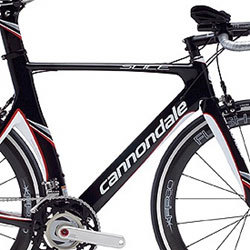
First among them was Cannondale. This company zagged last year when most of the rest of the successful tri bike companies were zigging. Felt, QR, Giant and Trek came out with new bikes made with Cervelo-style geometry and Cannondale, which had fine geometry in '06, went backward (literally and figuratively) during '07.
Then, during Grand Tour season, we see the covers come off a brand new all-carbon beauty. In yet another slap to the European companies which say proper tri geometries can't function in a UCI world, Cannondale joins Cervelo and Felt in proving this view wrong.
The '08 Slice rides as nice as it looks. This bike has 62mm of trail, and with this sort of steering geometry the thing wants to go in a straight line all the time. It's a dream to ride in the aero position, and because of its longish trail it can be ridden small (those on the border can choose a smaller size rather than the larger and it'll still be fine on high speed descents). But it's less good as an out of the saddle climber, and needs a pursuit bar with less "reach" to shorten the steering lever. This bike is a fine candidate for a HED one-piece.
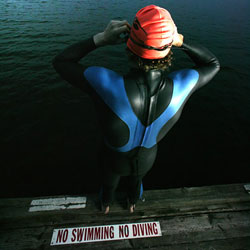
Cannondale has spit-canned all its prior tri-specific models and is betting everything on this frame, spec'd to achieve a range of price points, much as Scott does with its Plasma. Wise choice. This bike is the bomb. Cannondale bridges from the chase pack in '07 to the lead pack in '08.
Blue Seventy has undergone a quiet transformation in the last two years. Under the leadership of Tim Moxey, who replaced longtime Ironman wetsuit licensee Andrew Mundell, the patterns are spruced up and the brand has slid out from under its attachment to the Ironman name. Now it's Moxey's call as to whether he extends the Ironman license, but if he chooses not to he has a brand that can stand on its own.
The patterns and features no longer capture the Iowa farmboy mystique, but nicely fit a range of athletes with trim physiques. Blue Seventy may or may not triple its sales, but it's triple the company it was two years ago.
You've probably never heard of Inside Ride. The product this company made cost $30,000 and required its own room. It's not that it needed room, it needed a dedicated room, and this treadmill for bikes — a moving road, with it own asphalt-like surface and dashed white centerline — pulled your city's electrical grid to its knees when you turned it on.
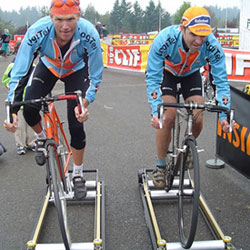
Never did I expect to see this company exhibit again, but there it was last year and again this, with something new and cool. Inside Ride has a set of rollers that you can't fall off of. You can ride its e-motion rollers in the aero position, out of the saddle, you can sprint on them. And, it's light, portable, and takes up no room. At $795 it's not cheap, but if one ends up at your house you'll never ride a trainer again. It also is not power-limited. Lay a thousand watts down if you can. Ride it with a power meter and you can do precise power-defined intervals.
Not only end users but those with fit studios will buy them too. Even the most confident fitters among us know that you'll have to ride the bike out on the road before the fit is "stuck." The Inside Ride's rollers allow for a rider to have that outdoor riding sensation without leaving the building.
This company’s hurdle is best expressed in what one of its better customers said of it: “They [those who run the company] are colossally hard to get hold of.” Maybe that’ll be less the case as it continues its increased success. But another thing is true: they [the rollers themselves] are colossally hard to get hold of at retail outlets. Very few retailers have them. Best to buy them online as of now, and you can find them at the Inside Ride website, easily googled.
SRAM has hoisted itself from mountain bike component maker to bona fide road bike gruppo status in 24 months. While it still may have a way to go before road racers embrace DoubleTap, I predict triathletes will flock to SRAM's OE spec.
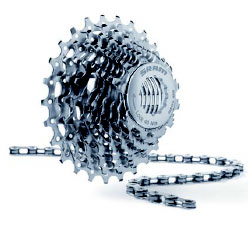
They’ll do so on the back of nifty new bar-end shifters and plug-in brake levers that neither Campy nor Shimano can match; early and eager adoption of compact-style cranks; a chain with a sensible master link; parts that compare favorably — if not yet quite comparably — with those made by Shimano and Campagnolo and, quite soon, wheels from an acquired company triathletes know and love.
I've spoken to two companies that are major players in triathlon who plan to spec SRAM groups. Yes, they're crossing their fingers, but I don't think they'll have anything to worry about. SRAM is just the kind of company triathletes tend to embrace before roadies do, and triathlon will prove a window into the road race market for America's first comprehensive gruppo maker.
Profile Design is not what you’d call a flashy company, but it executes. It’s reliable. It hasn’t always been that way, but you have to go back almost a decade, under prior management, to find a time and a set of products where that wasn’t so. Execution, safety, reliability, became the current management’s core values, and they’ve achieved a reputation for this throughout this decade.
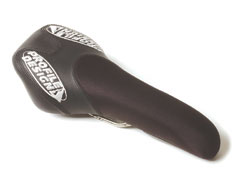
So it isn’t the Big Thing you’ll see at Profile Design from one Interbike to the next. It’s a set of little things that represent problems solved. Against that backdrop, consider two aerobars that debuted this year. In each case they were more the new and improved than the brand spankin’ new. One was the stylish and functional Sonic Stryke, and the other was the upside down “Bjorn mount” T2 factory reconfigured as the new Carbon Stryke. We now, as a result, have two low-profile aerobars from Profile Design to go with its higher-profile cousins.
The lower profile Carbon Stryke bar has extensions passing underneath the pursuits, and armrests passing just on top. This means the bar is best ridden with Profile’s race bend extension that which has been used successfully on the Carbon Stryke and other bars for years. The next logical step for next year would be to make a set of Cobra S-bend extensions with the distal end rising 2 centimeters higher above the proximal end than they now do. If you have no idea what I’m talking about, I’ll explain this in more detail when I write only about Profile’s bars for 2008. Suffice it to say that Profile Design, though not alighting the firmament with new paradigms, is making all the moves it should make. I might add that it has also incrementally improved its tri saddles (pictured), which are my favorite of all saddles used in the aero position.
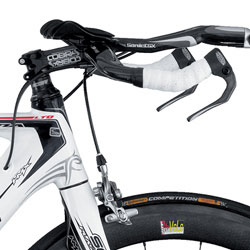
So let’s talk about how the Profile Design aerobars mate with another company that needed to take a step in the right direction, and did so. Scott committed two rights in 2007 that conspired to make a wrong. It spec’d a high profile aerobar on a tall head tube. This meant you were in for a bad fit on your Scott Plasma unless you were long-legged versus your torso, or unless you did what both of Scott’s star triathletes – Cameron Brown and Ain Alar Juhanson – did and chose low profile Visiontechs in place of the Profiles that come OE on these Plasmas.
It was therefore with satisfaction that I ambled into Scott’s Interbike booth and saw a lovely new whitish Plasma with a set of Profile Design Sonic Strykes that looked as if they were finished to match (though they weren’t, it just happened that Scott and Profile had the same cosmetic idea in mind). Scott has now taken a strong leap forward for ’08, without doing very much. It simply spec’d parts that were a better match for its bike.
Scott’s good decisions may not seem to you worthy of a standing ovation, but when I place this common sense approach against the backdrop of a lot of companies whose principals refuse to entertain the slightest notion that they might be wr… wro… wro… wrong (perish the thought), I consider it a breath of fresh air when a firm moves the ball down the field through identifying and shoring up its weak links.

